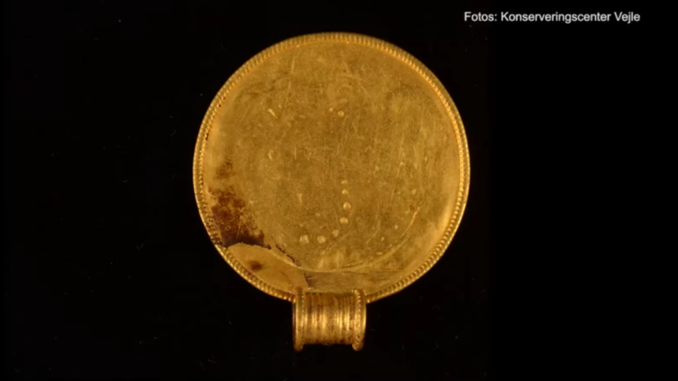
Among the most common reasons people buy a metal detector lies the hope they’ll find something valuable or historic. Coins, watches, rings, jewelry, silver, gold, musket balls, antique metal buttons, and ancient artifacts are prime examples of the discoveries treasure hunters dream of finding. Public beaches are popular places to look for items that can be turned into cash. A quality metal detector isn’t cheap, and it’s nice if it pays for itself. Most people who get into the hobby never find much of remarkable value or interest, even after years of looking. A man in Denmark, who had never used any like device before, struck gold in the middle of a field on his first try.
Ole Ginnerup Schytz was trying out the hobby on a friend’s land near Vindelev, Denmark, last December. When the detector went off he dug a hole in the ground and pulled out what he at first thought was a muddy old bent lid, with scratches all over it, from a can of herring. After cleaning it up, he sent a photograph to the Vejle Museum in the nearby city of Vejle. Museum staff were astonished, recognizing immediately the significance of the gold medallion engraved with runes. At least 1,500 years old, it dated back to the sixth century: clearly late Iron Age, pre-Viking Age. A team of archaeologists were dispatched to the site, where they spent nine months excavating for additional treasure. In total, about two dozen items were found including the gold medallions, coins, and jewelry in the form of bracelets and pendants. Ole’s discovery has been named “the Vindelev hoard”, one of the largest caches ever found in Denmark.
Researchers theorize that the treasure belonged to a high-ranking chieftan, based on the exceptional value of the hoard. Only the most wealthy and powerful could have owned such splendor, an exceedingly rare collection for that era. There are two theories regarding the motivation a chieftan might have to bury priceless riches. Perhaps it was hidden to protect it from invaders. Or maybe it was an offering to appease their gods, a theory that also includes a number of other hoards previously found in the region. A large volcanic eruption dated to 536 AD (sixth century) sent an ash cloud over Scandanavia that has been linked to crop failures and famine. With that knowledge in mind, it’s not hard to imagine the locals offering up their most prized possessions in return for food.
Ole called his beginner’s good fortune, “the epitome of improbable luck”. The Vindelev hoard will be on exhibit at the Vejle Museum beginning in February. Now dig this video featuring Ole at the very beginning. The language is Danish. Unfortunately English subtitles are not available, but at least you can get a glimpse of the area where the treasure was found.
“Kæmpe guldskat fundet ved Vindelev nær Jelling” (Huge gold treasure found at Vindelev near Jelling)
(2:36)
Question Of The Night: Have you ever found anything with a metal detector, or have you ever wanted to try?
